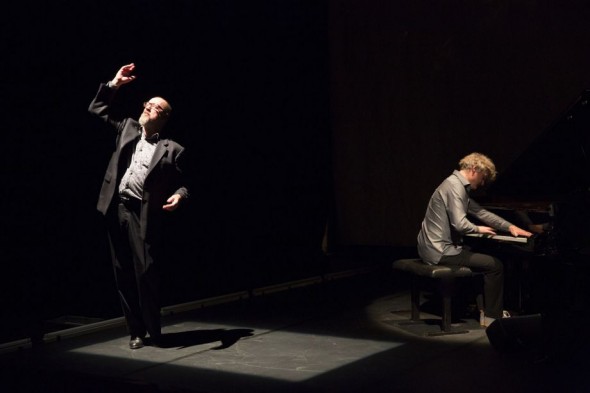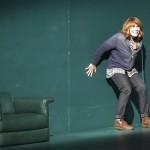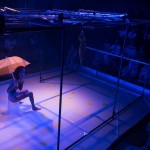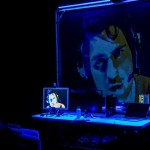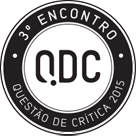MITsp 2016 – 6 reviews: Joël Pommerat, Dimitris Papaioannou, José Fernando Azevedo, Josse de Pauw e Krzysztof Warlikowski
Theatre Critics from Rio de Janeiro write about 6 plays of the 3rd MITsp
Vol. IX, nº 67 abril de 2016 :: Download complete edition in PDF
By Daniele Avila Small, Mariana Barcelos and Patrick Pessoa
Translated by Dermeval de Sena Aires Júnior
The following critiques were presented in March 2016 on occasion of the 3rd MITsp – Mostra Internacional de Teatro de São Paulo. They were written by Daniele Avila Small, Mariana Barcelos, and Patrick Pessoa, of the Questão de Crítica magazine, who participated of “Prática da Crítica” [“Criticism Practice”]. This activity has been promoted by the festival since its first edition in 2014 and is part of a broad set of formative activities included in the exhibit Olhares Críticos [“Critical looks”].
The activity “Prática da Crítica” was carried out by the criticism platform DocumentaCena, which brings together the ideas and actions of four Brazilian websites of theater criticism: Horizonte da Cena, from Belo Horizonte (http://www.horizontedacena.com/); Satisfeita, Yolanda?, from Recife (http://www.satisfeitayolanda.com.br/blog/); Questão de Crítica: Revista Eletrônica de Críticas e Estudos Teatrais, from Rio de Janeiro (www.questaodecritica.com.br); and Teatrojornal – Leituras de Cena, from São Paulo (http://teatrojornal.com.br/). These four virtual spaces were created by theater journalists, critics, theorists and researchers who have collectively worked for a number of years in order to propose actions that may expand the field of theater criticism. “Prática da Crítica” also counted with the partnership of collaborators from the website Agora Crítica Teatral, and of the independent critic Miguel Arcanjo Prado.
At “Prática da Crítica”, each critic wrote about two plays of the program of the 3rd MITsp festival. Daniele Avila Small wrote about the two plays staged by Joël Pommerat: Cinderela (Cendrillon) and Ça ira. Mariana Barcelos wrote about the plays Still Life (Natureza morta), by Greek director Dimitris Papaioannou, and Cidade Vodu, by the company Teatro de Narradores, from São Paulo. And Patrick Pessoa wrote about An Old Monk, staged by Belgian director Josse de Pauw, and (A)Pollonia, staged by Polish director Krzysztof Warlikowski.
The texts were originally published in Portuguese at the MITsp website (http://mitsp.org/2016/blog-olhares-criticos/), and both texts by Patrick Pessoa were also published at the website Agora Crítica Teatral, which sponsored his participation at “Prática da Crítica”. We came to feel it would be desirable to produce English translations of these texts for the present edition of Questão de Crítica, in order to make the specific nature of theater criticism produced in Brazil available to the international directors and producers responsible for the plays in question.
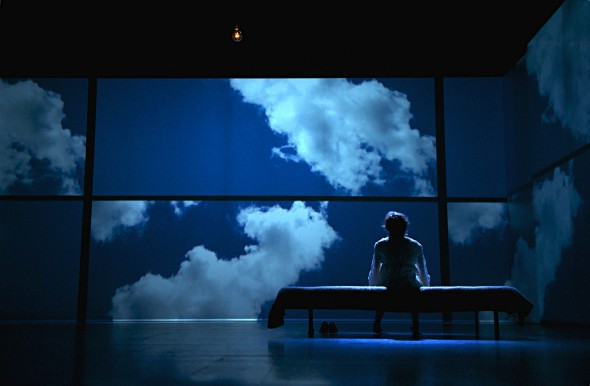
On narratives in theater and theater narratives
A critique of Joël Pommerat’s Cinderella
By Daniele Avila Small
Originally published in Portuguese on March 4th, 2016, at: http://mitsp.org/2016/das-narrativas-no-teatro-e-das-narrativas-do-teatro/
In dramaturgy, it is a common procedure to have theater look back upon itself. The great classics that make the history of theater are continually revisited by present-day artists, ranging from the most traditional type to those who seek to produce new forms. In some cases, artists are driven by the idea of entering the history of theater on account of memorably performing a great role, or of efficaciously staging a play. In these cases, the usual result is merely an accumulation. Yet, in other, rarer cases, the staging of a classic piece occurs when someone has a hypothesis about its narrative, with an outlook that not only continues, but also reinserts its text into the world and allows theater to encounter itself in its history, by sewing some additional threads to this history in one’s own times.
Recounting narratives is common practice for humans. The great stories that constitute us are perpetuated by theater, by the movies and by literature. In the case of children’s tales, these stories are also transmitted in oral form, and their narratives impress on their hearers some structures of feeling and thought. Later in life, we often try hard, time and again, to cast off many of those structures.
To recount Cinderella, as one reflects on Joël Pommerat’s staging of its story, is not merely to repeat Cinderella. Standing before this play as spectators, we can ask which hypotheses are put forward by this staging in relation to its narrative. We can also ask which hypotheses may be formulated based on what we see. We may ask, for instance, which deep structures can be identified in Cinderella as we conceive her originally, and how these structures are now deconstructed in Pommerat’s play.
The standard Cinderella is not a complex character, since she is not portrayed with an intimate dimension, and since she experiences the movement from unhappiness to happiness due to external factors, and to a Christian idea of deservingness, according to which a person who suffers and remains humble shall be rewarded with happiness at some point. Her message for girls is: ‘stay home, do domestic work and conform to your family, even if you do not feel that you belong to it at all, because one day, an external factor will manifest itself and your relation with a man will bring you happiness. And all women of the world (a fairy is not of this world) will either abandon you or wish you ill’.
Pommerat’s Cinderella has an inner dimension, with a past and a meaning (though a crooked one and the result of a misunderstanding). The trials she must face are largely self-inflicted, and she is also co-responsible for her own afflictions. The external, magical factor becomes a fallacy: the fairy does not act as a fairy, but as a friend. Or, in other words, what saves Cinderella from mental confusion and self-confinement is friendship among women. The man she loves is as lost and has as many neuroses and traumas as she, and no matter how pleasant is the relation they are about the have, this relation is not their telos – it is not the final aim of their lives.
Plot subversions such as the shoe frolic, the girl’s lightly blasé posture, the scene of the great moment of the couple when they are dancing together alone and not fused in the élan of a romantic soap opera kiss – each of these aspects can be explored in fantastic discussions. The stepmother’s self-deception, for instance, is so comic at first sight, but so sad and moving as the scene unfolds, that it deserves an analysis in its own right. Each actor’s work; the inventiveness of the scene elements; and the dramaturgical operations of the play’s author-director: all these features can also be highlighted and critically developed in detail. However, the entire formal work of constructing this play converges into the issues of structure and theme, and prompts us to think about its topics.
The big secret is found precisely in the new fact of the tale: the effect of the mother’s words on her deathbed.
On the one hand, we – boys and girls alike – are all haunted by the words of our parents. Within this mood, the play slides from the feminine myth that chases us to the surviving terrors of childhood in the adult mind. But beyond this mood, the tale is entirely based on the inability to listen, on misunderstandings, and on the sense of mishearing. The movement from unhappiness to happiness, as it is experienced by Pommerat’s Cinderella, is a movement from not being capable to listen to the other person to being capable, at last, of doing so.
Theater is not simply meant to be seen, but is also, and particularly, meant to be heard. After all, it is in the relation between speaking and listening that its most archaic origin can be found. Therefore, it does make sense that no matter how much the visual aspect of spectacles may guide several contemporary creations, the narrative element always manifests its strength and takes its seat. It is a sign of the actuality of the MITsp program that its third edition started with such an exemplary display of the mythic, ancestral and telluric force contained in the reinvention of narrative in theater as this one.

Confident bodies and the battle against weariness
A critique of Joël Pommerat’s Ça ira
By Daniele Avila Small (Questão de Crítica / DocumentaCena)
Originally published in Portuguese on March 5th, 2016, at:
http://mitsp.org/2016/os-corpos-convictos-e-a-batalha-contra-o-cansaco/
It was not a simple experience to watch Joël Pommerat’s Ça ira on March 4th, 2016, as Brazil undergoes a crushing process of production and manipulation of discourses to steer public opinion onto a retrograde path of tragic dimensions. It was not a simple experience to hear the statements of clergy representatives in the play while bearing in mind the discourses of Brazil’s Evangelical bench, and while recognizing the linkage between the Catholic Church and the military dictatorship that a specific segment of the press (!) now wants to rekindle. It was not a simple experience to hear the representatives of the nobility in the play while bearing in mind that the hard core of political polarities in today’s Brazil is the feeling of hate by the middle and high classes against the poor. Brazilian political nerves are now exposed. On the one hand, we can be thankful for the actuality of Ça ira and for the importance of having the opportunity to watch this play in this particularly delicate week. On the other, it is a sad finding (although we already knew it) that the level of the political discussion we are currently watching on TV resembles that of the days prior to the French Revolution.
Indeed, the heat of the moment calls for a discussion beyond the stage. Yet, the formal aspects of this play also evoke our critical sense. This staging places us in different structures as spectators. At some moments, we stand before scenes that turn back upon themselves, and unless mistaken, I identify these scenes as the ones in which the king is in his family environment. At other moments, we become the destination of ready-made discourses as the word is directly addressed to us. But most of the time, we stand in the eye of the storm inside the space of the assembly. This staging strategy allows us to feel quite concrete variations of emotional and physical states. And this oscillation of states seems to have a pertinent effect on us as spectators, since it reflects the conditions in which we, as citizens, find ourselves when we stand before a few impasses that we do not know how to solve, or cannot solve.
At some moments, we feel we are not part of the political discussion, that is, we feel our participation is dispensable and the fourth wall of the theater is actually the fourth wall of the great powers. At other moments, we know that we are not real interlocutors of the discourses cynically addressed to us – and this may alienate us even more than the fourth wall. But during the moments of the assembly, politics encourages us and make us want to shout, to boo, and to applaud. The theatrical power of the assembly makes us realize the theatrical power of theater itself. We are not prompted to literally engage ourselves in movements and displacements, but the theatricality of the assembly produces in us a consciousness of our posture on the theater seat, especially when the confident bodies around us reverberate with the same intensity of our own heartbeat.
Dramaturgy evokes our attention in a particularly valuable way when it creates a debate with lines that are not structured in a manicheistic way, or when something negatively surprises us in a discourse with which we were already agreeing in a lively way, or when we can realize a glimmer of reason in a discourse with which we were in disagreement from the start. The way this play presents Louis XVI is complex. We know his head will eventually fall, and we even expect this moment with a measure of anxiety. But the symbolic strength of monarchy in the minds of French revolutionaries is something that we, as 21st century Brazilians, cannot envision very well. Or can we?
Moreover, it is significant that this play does not reach the point in which the king is decapitated. We find signs of a tragedy in Louis XVI as a character and in the narrative of Ça ira, but a catharsis does not occur. After the play, we go back home with the image of the king with his head above his shoulders. And in a particular point in time, some spectators might have thought that being in the theater while a media circus is established out there can be as distressing as being in an assembly to discuss the rights of men while blood was being shed on the streets.
The duration of this play also has an effect on our bodies, minds and affections. Extension is an element of dramaturgy, since it concretely acts on the states of mind of spectators, touching their points of resistance and overthrowing some of these points, while provoking others. Five hours of theater in a foreign language is not “for the weak”. Yet, we must remember that politics, to a large extent, is a foreign language too. And weariness is one of the most efficacious strategies in the big projects of spurious maneuvers, such as the one we are now witnessing in Brazil. Our intellectual and physical exhaustion at the end of the play acts as a mirror to our deep fatigue at this moment when we must cope with the nasty methods of those who turned politics into a profitable business.
One of the pacts in theater is to stay to the end. Let us then remain awake.
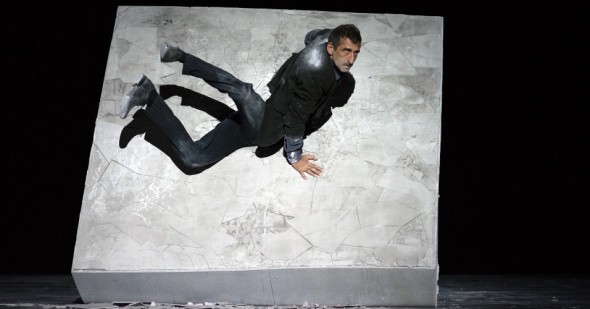
Acting in lifeless times: Theater and the still life of every day
A critique of the play Still Life (Natureza-Morta)
By Mariana Barcelos
Originally published in Portuguese on March 7th, 2016, at: http://mitsp.org/2016/agir-em-tempos-mortos-o-teatro-e-a-natureza-morta-de-todos-os-dias/
Still life [in Portuguese expression, natureza morta, or ‘lifeless nature’]; nature as found in biology; in the human body; its organism. Dead, what once has been alive: the concreteness of the physical state of matter; a dimension that can only be grasped in the course of time.
As one casts a glance to works of the Still Life genre, two of its inherent features stand out and guide their narratives between the material aspect of objects (food article, human body, flower) and the time that elapsed until their death. One trace is solid, while another extends itself. The Portuguese expression depicts a finite object (it’s dead, period). In the English expression, apparently inanimate objects survive their own death – still life.
The play Still Life (Natureza-Morta), by Greek director Dimitris Papaioannou, had its premiere on March 4 during the 3rd edition of MITsp at SESC Vila Mariana. The latent tension embedded in its title (at first sight, a twist of words involving two languages) already gives a hint of the issue that cuts through its scenes, in which seven actors exhaustively repeat a number of actions with the purpose of keeping a dead object alive.
In this case, bearing in mind the myth of Sisyphus, being ‘dead’ can be interpreted as not moving on, in spite of being in motion. Or – and reversing the intrinsic logic of still life –, the moving body is alive (trying), as the time spent with its repetitions dies away. It is like producing action in a lifeless time and looking at still life not from the perspective of painting, but from that of dramatic action and theater. It is like acting within the stillness of time, and this is precisely what this text proposes. Papaioannou sets out to construct a refined dialectic, which embodies time while dilating the bodies of the actors in the time-lapse of the scenes.
The play begins with the audience lights on. An actor is on a dark chair at the center of the front stage and handles a rock while looking in the direction of the audience in a state of apparent neutrality. The audience lights fade out slowly, as a black stage from floor to ceiling displays a brilliant (though not yet fully sharp) dark bubble over its entire platform. Someone walks in and removes the actor’s chair. His body stands unmoved in the previous position, as if he had remained seated, and it becomes evident that in order to endure such a deceptive immobility, a great deal of effort and physical work is necessary. As the actor remains static, one can notice that he is still acting: and so it is possible that such image may represent the idea of action itself, since in the absence of action, his body would fall to the ground. Action is force.
‘Lifeless nature’ is thus caught in theater by the primordial condition of action, even in a state of immobility. Here, considering the physics of the bodies of the players, to act (to be alive) is to exert a force on something. The chairless actor slowly changes posture, walks to the back of the stage and disappears. Time elapses. We hear sounds of falling objects like tiles; sounds of a construction site. Time elapses. Another actor walks from the back to the front of the stage carrying a notably large piece of wall on his back, with approximately twice his height and stretching out to his sides in such way that it would be impossible to embrace it. It is a dead weight on someone’s back.
For a time period superior to our yearning to grasp the action on the stage, this actor forces his body against the wall to keep it standing. In the course of its scenes, the play constantly follows this pattern, which seeks to unlock the time of comprehensibility and strip naked the material tension of its objects and of the human body. It empties out its narrative dimension and exposes a slow time in which the static quality of pictorial frames can be glimpsed. Time has no continuous chronology; it is defined in a static, suspended period when actions are repeated as if being in a single instant. It is a time-body that the naked eye cannot perceive in the regular course of life, as if caught by an extremely slow (negative) camera shooting a split-second when it becomes possible to see infinite actions as they repeat themselves – eternity.
Therefore, the conditions for this notion of time can only be based on the crude physicality of matter and have no particular significance. One either hears the sounds produced by the objects, or silence. Sounds are highlighted by the microphones distributed along the stage floor, and exist in material terms as sound waves: when a broken glass falls from the wall, its sound is heard, and so it is when adhesive tape is pulled from the floor. Lighting ranges from glare to darkness without a semantic of its own. Surfaces at the scene are solid, liquid or gaseous. The wall is a bloc, and the net-shaped plastic piece that appeared as a shining dark bubble on the ceiling earlier in the play becomes gradually illuminated during most of the show, with the paradoxical function of storing smoke. The once solid wall is now turned into fragments, while smoke acquires density inside its plastic structure and sometimes takes shape as: cloud, sea, body cell. All these forms can be reached and modified at the touch of a shovel.
Dilated time thus brings the audience closer to the materiality of things, even though the play’s powerful narrative emerges sometimes to the surface of the scene as small lightning bolts. To dilate time is to look through a microscope and notice the details of observed objects before the organism, before causality and narrative, and before giving names to the organs of the body. This is the stage in which all is one; body that is also a wall, and also is time. Body-wall-time, a composition that can only be changed by a modification of its physical states.
It is unified and concrete, as well as the bodies of the actors. Wearing outfits in the same tones and with small distinctions, resembling usual work clothes sometimes, the players act on the stage as one single mass; a unified piece; a choir. There is no “I”, no character, no figures, and so on. The actors are performing on stage, only; they are acting, pure and simple. Each actor recurrently takes the place of another in what could be characterized as the living notes of one physical score, or choreography, in which their bodies connect and appear as one single body. The strongest image that can be described to illustrate this effect is the moment when the actors successively pass through a hole on the center of the wall; one of them comes from the back, while another “enters” by the front, and the figures of their bodies resemble a jigsaw puzzle in which a new body is formed by the body parts of more than one actor. Thus the upper part of the resulting body belongs to one actor, while the lower part belongs to another, and many other exchanges can be seen in this same sense. The body is at once fragmented and expanded by all bodies on the scene.
As a striking metaphor for life’s daily repetitions, for the work of the masses, and for the eternal rolling of the stone of Sisyphus, this play can be seen as a criticism that refuses to live under the constraints of myth. But if the myth (the narrative), on the one hand, is what takes life away, then Still Life is the force that keeps one alive (acting), though in a lifeless time. Time, in life, is not arranged in suspension; running away from the myth is therefore closer to utopia. Instead of being destined to the inevitable weight of history, this spectacle proposes an autonomous dimension for its narrative, though in a dialectic relation. Your routine is there, lifeless; but you are not.
The weight of the wall on the back of the actors leaves at most a trace of dust. As a matter of fact, the wall itself is but a large sheet of foam. Still, the dead can be beautiful. In the penultimate scene of the play, the actors bring a table to the front of the audience and sit down around it for a typical Mediterranean meal. Different types of fruits, tableware, inanimate objects of still-life paintings. The aroma of herb and olive is pleasant. This scene simulates a meal among friends, as the actors gesticulate as if having a conversation. Yet, not a sound is heard. In fact, the entire play has no spoken lines at all. The human voice cannot propagate when time stands still. And it is not necessary to hear a voice in this case, since any person can guess the commonplace words humans say in the frugal meals of every day. Anyone can hear this silence. The voice of this narrative is in the mind of the spectator, who cannot evade it. The beautiful scene on the stage is an unmistakable example of the lifeless routine we are so delighted to replay.

If I could, I would go back today
A critique of the play Cidade Vodu (Voodoo Town)
By Mariana Barcelos
Originally published in Portuguese on March 9th, 2016, at: http://mitsp.org/2016/se-eu-pudesse-voltaria-hoje/
When a biographical or confessional narrative stands out in dramaturgy as the element that gives form to a work, it is equivalent to saying that fiction, as an option, would not be enough. An intimate account is the belief that one can neither simply evade what he or she is hearing, nor remain tranquil with the pleasant idea of “Theater, lie”.
From the numerous features of this type of dramaturgy, I highlight two. The first one is that when a person decides to speak about oneself, we assume that the contents of his or her story or text can be expanded outwards. We presume that this account tells a somehow collective story that may concern a large number of individuals and, for this reason, conveys something relevant (an expectation that it not always meets).
The second aspect is that its intrinsically affective lines generally produce a connection with the spectators. What one has to say matters; one is emotionally and affectively involved in the story. And if what he or she says is relevant, then writing a critique of this story based on the technical aspects of theatre seems to me a quite questionable and awkward enterprise. It would also diminish the importance of the enunciation – in the case of Cidade Vodu (Voodoo Town), staged by Teatro de Narradores, I would have neither the authority nor the right to make such a critique from this white body of mine.
Cidade Vodu chooses a number of historical accounts to depict a lineage of racism in the recent centuries from the standpoint of the Haitian nationality of the actors on the stage. Its lines present a chronological sequence that starts in the period of slavery, and then switches between stories that contrast a detailed description of the barbarous violence experienced by the Negro populations of Haiti, on the one hand, against the discourses of men who held the power back then, on the other. Next, it depicts Haiti’s colonial period under Napoleon Bonaparte’s rule of continuous cruelty. And its final scenes deal with the Haitian immigration to Brazil after the earthquake of 2010 and the arrival of the UN peace troops in the country in partnership with the Brazilian Army (the MINUSTAH mission). The stories of this final part describe the lives of the actors themselves, as Haitian artists who recently immigrated to Brazil due to the unbearable and unworkable life conditions they underwent at home after the earthquake. This part is the most touching one, as it speaks of the unimaginable pain experienced by those persons, and places an emphasis on the way the Haitian population was treated both at home and in Brazil, while also describing the geographical route of their migration. The narrative ends with memories of violence and brutality inflicted by the Army (which purported to reestablish peace through criminal acts), and prejudice on Brazilian soil, and identifies racism as a structural element of the societies, which is not restricted to specific circumstances in the course of historical time.
Approximately half way through the play, a party takes place at the actors’ invitation. The public has then an opportunity to sit down and eat, drink, talk and dance in a broad space at the sound of typical Haitian music, sung by the actors themselves. One of the actors presented this space to me and another spectator named Julia as the “Voodoo” Town, in reference to the voodoo dolls through which an individual can allegedly inflict punishment onto a virtually defenseless victim.
The three of us conversed for a while. Julia asked him if he wished to go back to Haiti. He replied, “If I could, I would go back today”, and laughed. Our exchange of glances was one of empathy, even if Julia and I could not know anything about this anguish. Even in a condition of voodoo victim, the town produces a joyful and warm encounter. Some of the stories that were shared that night did seek to involve their hearers. Yet, they did not weaken the vivacious mood of those who then proposed peace to those who almost always turn their backs to them.
The words of one of the stories of that night reverberate as a historical echo: “each one of us is here because of the other”. If being together has recurrently been based on clashes, confrontations, resistances and struggles, the Voodoo Town, on its turn, proposes a festive encounter against the modus operandi of our world, which finds it logical to make war in order to attain peace. If the purpose, here, is the encounter – and how could it be otherwise? Let us then encounter.
The second life
A critique of the play An old Monk
By Patrick Pessoa
This text was originally published in Portuguese at the following link: http://www.agoracriticateatral.com.br/criticas/60/an-old-monk. I am thankful to Agora Crítica Teatral and the Goethe Institut for sponsoring my travel expenses to the 3rd edition of MITsp.
He was fifteen, sixteen, seventeen years old. He felt like he did not belong to his life, as if he had missed the correct address. All other boys around him had a great deal of dance and talk, lived in bands and had fun. They would always repeat the same stories: the latest booze news, that crazy acid trip, the best joints, the first times they got laid (described with the air of indifference typical of the young wishing to look experienced). They were fifteen, sixteen or seventeen years old, and seemed to think they were in the best period of their lives. But he did not think so. He wasn’t suited for his body, with its profusion of weird hair and painful zits. Being a teenager meant for him a type of suffering for which he had not yet found a name.
One day, in a party, he felt unsettled after a friend told him that she was in anguish. Those were beautiful words: “in an-guish”. They had the flavor of an exotic fruit, which he swore he had not yet tasted. That was when he read in one of those books people only read when they are fifteen, sixteen or seventeen years old, that life is ‘somewhere else’. And he did believe it. After all, life – real life – had to be somewhere! He shook with fear as he thought that he would not live enough to know it. For many nights, with his manhood in his hands, he prayed to God so he would not die a virgin. He chanced to find a youth exchange program and ended up in the Netherlands, attracted by the mirage of legalized marijuana. Who knows that could prompt other liberating experiences? But after he arrived in the country, his feeling of being an ontological foreigner only worsened. At that time, Albert Camus became an addiction. He learned Dutch by reading the subtitles of a US soap opera, The bold and the beautiful. And thus, without even realizing it, he actually assimilated that strange language. A mother tongue that one chooses to learn can sometimes impress itself even more strongly than the tongue and the mother that had been allotted to him by fate.
After his return from the exchange year, his father sought to become closer to him, and started taking him to the jazz shows he attended passionately. At the age of twenty, twenty-one, twenty-two, the young man saw and heard musicians whose names he could never remember, but who were always referred to by his father as “fucking awesome”. The sensation he had in those shows was a weird one. Their first notes would already transport him to a quite distant place. The fact that the musicians seemed to play more for themselves than for the audience was a cue for his own disconnection. He would generally think about the life that could have been, or the life that could still be, but… He would often feel guilty for not being capable of appreciating his privilege, since those concerts were usually expensive. He knew that those musicians were technically good, but it seemed to him that something was missing: maybe he lacked a more refined sensibility to enjoy the things that words cannot describe, or the freedom of surrendering himself to a flow of cruder and more abstract sensations beyond rational comprehension.
At the age of thirty, thirty-three, thirty-five, his body continued to be inappropriate, but he had a life that others considered to be actually good. Or, at least, a life they considered to be normal. He had a wife, a son, and a work that allowed him to live without serious financial worries. He had so many obligations to fulfill that he would rarely remember how life had not yet given him a tenth of what he expected. As when he was a boy, he continued having the fear of dying too young. Now, at least, he was no longer a virgin.
At the age of forty, he went to São Paulo to cover an international theater festival. Some people would consider him a theater critic, even though this ‘outfit’ looked like a rented suit from a second-hand store. He watched the play of a Belgian director, named “An old monk”. Since he knew he would have to publish a critique in less than 12 hours, he previously looked for more information about Josse de Pauw – the author, director and performer of the show. He found that that de Pauw did not refer to his work as a “theater play”, but as a “theatrical concert”. After the spectacle began, he understood why.
He found a music band on stage, including piano, electric bass and drums, which played some jazz just like the music he used to hear with his father twenty years earlier. He remembered his old man and smiled with the corner of his mouth: “these musicians are fucking awesome!” Next, he saw a corpulent bald man with a long white beard – a mix of Xico Sá and Paulo Cesar Pereio – enter the scene dancing, and surrendering to the flow of the music. He danced for a long time, until he became really tired. That was a quite interesting device, since it turned tiredness into a real corporeal experience beyond representation pure and simple.
Josse de Pauw then started his narrative, always dialoguing with the rhythm of the band, which continued playing during the entire show, always keeping in mind the need to construct an inclusive relation with his audience. The simple but powerful magic of this device was a result of the fact that in spite of referring to seemingly autobiographical experiences, de Pauw spoke in third person, thus turning his own life into fiction and accomplishing the pipe dream of converting his own life experience into a work of art (in the play’s epilogue, by the way, this idea was reinforced by the projected image of his naked body with graphic interferences that turned de Pauw’s figure into several different sculptures ).
De Pauw used dance as a metaphor in order to speak about the three main periods of his life: youth, when he danced tirelessly and time seemed infinite; adulthood, when his obligations made him stop dancing; and his present mature age, when after uselessly striving after the silence and solitude that characterize the life of a monk, he regained the desire to dance and sing as Thelonious Monk, in spite of all physical limitations. And so, even before grasping the central thread of the play, the boy with the ‘suit’ of a critic was pierced by a strange feeling of belongingness: de Pauw was not only speaking Dutch – the second language he thought he had forgotten. Above all, by acting as a jazz-raphsode, Josse de Pauw was bridging the abyss that had always kept that Brazilian boy away from instrumental music: the lack of words. Before the astonished eyes of this critic, de Pauw was celebrating the marriage between life’s musical flow and the narrative capacity to transubstantiate cruder sensations into intelligible meanings.
I left the theater dancing, with the impression that I was now in tune with the rhythm of life, and rejoicing at the feeling that I was no longer a foreigner in this world. In de Pauw’s words, “Do not seek too much peace, for there is still time for another life, if necessary. There is time for another, and perhaps also a better life, even if the previous one has been already good”.
A second life, without a doubt, hinges essentially on the possibility to articulate a narrative of the scattered fragments of our discontinuous experience of time. This task, as I see it, belongs not only to art, but above all to criticism.

Apollo? No!
A critique of the play (A)Pollonia
By Patrick Pessoa
This text was originally published in Portuguese at the following link: http://www.agoracriticateatral.com.br/criticas/65/apolonia. I am thankful to Agora Crítica Teatral and the Goethe Institut for sponsoring my travel expenses to the 3rd edition of MITsp.
To write in the heat of the moment about a spectacle as complex as Krzysztof Warlikowski’s (A)Pollonia is a daunting enterprise. The multiple languages employed by Warlikowski on stage (including music, theater, video, installation art, performance, stand up show, academic conference and puppets), along with the plethora of his more or less explicit references (ranging from Aeschylus to Jonathan Littel, including Euripides, Kafka, Coetzee, Hanah Krall, Godard and many others), and his ambition to expose linkages among some of the oldest issues of human life (the necessity of a personal sacrifice for an ideal, or for one’s neighbor; the rebellion against the “gods” and the unacceptable fate imposed by them; the inherently tragic character of any human decision, and the inescapable “innocent guilt” of tragic heroes), while bearing in mind the need to approach Poland’s recent past and expiate its guilt in the extermination of the Jews (in Warlikowski’s words, “the harrowing legacy that burdens our descendants”): all these elements would doubtlessly deserve the space and time of a more elaborate and consistent reflection (a warning to readers: the hermetic, or even confuse construction of this introductory paragraph intentionally sought to translate into the prose of criticism my experience as a spectator before the many layers of this show).
Indeed, it is a daunting enterprise to write in the heat of the moment about a political-theatrical event I am still far from having fully processed. Reductive simplifications and hasty judgments seem to be, in this case, a fate as inescapable as that of the (both Greek and modern) heroes brought to stage by Warlikowski. It would be prudent to wait for a more opportune moment when the adequate conditions for such a reflection could be riper. But the problem, assuming that this moment would someday arrive, is that it might then be already too late.
Tomorrow – March 13 – will be an eloquent date in Brazil, on account of the association between the number 13 and the national Workers’ Party, which was originally inspired by the same ideals that stood behind the creation of Polish trade union Solidarity (the movement that sought to combat Poland’s historical conservatism based on a proletarian approach to politics). Driven by a curious saintly furor, the fraudulent press of our “(A)Pollonia” is calling the nation to a “patriotic” march against “all the corrupts” (today’s “Jews”), instigating an ingenious and histrionic polarization between “us” (righteous and pure ones) and “them” (the corrupt and impure ones). However much we should bear in mind the differences between the Brazilian and Polish historical contexts, and between our own days and the first half of the 20th century, when Nazism and Fascism led to the extermination of millions of persons; and although this analogy may seem exaggerated; right now, in the heat of the moment, I am constantly reminded of a famous passage of Walter Benjamin’s essay On the concept of history, which states: “The astonishment that the things we are experiencing in the 20th century are ‘still’ possible is by no means philosophical. It is not the beginning of knowledge, unless it would be the knowledge that the conception of history [based on the idea of progress] on which it rests is untenable”. From this viewpoint, we stand not before the question of alienated humanists – “Oh, how could all these horrifying facts have occurred?! Oh!” –; but, instead, before that of the materialist observer who reads history against the tide: why is it that phenomena such as Fascism, Nazism and the Shoah do not occur much more frequently?
With the world at war – the list of current conflicts is so extensive that there would not be enough space for them here, including the conflicts of our private war in Brazil, which are causing a genocide of thousands of young Afro-Brazilians, and were portrayed by the resounding performance Em legítima defesa [“In self-defense”], one of the high points of this edition of the MIT festival – and with all current ethnic, religious, political and economic polarities between East and West, and with the upsurge of a Cold War that many thought of as being definitely finished after the fall of the Berlin Wall, etc., etc., etc., maybe acts inspired by a sort of Nazi-Fascist inspiration occur much more frequently than the invariably damp eyes of peace-friendly humanists could possibly see. And so it seems to me that one of the structuring intuitions at the basis of Warlikowski’s show is that the ideological assumptions behind the outbreak of totalitarianism in the 20th century are still alive and kicking at the dawn of the 21st century – perhaps constituing “the harrowing legacy that burdens our descendants”, which (A)Pollonia refers to.
If (A)Pollonia is not only Poland, but also Brazil or any place where the conditions for phenomena similar to the Shoah continue to exist, then I would dare to say that the show I watched yesterday is not about Poland, but about Apollo. The overarching image I identify in the chaos of visual stimuli and heterogeneous words that were literally dumped on the spectators – only apparently in an arbitrary way, just like any work of art that deserves such a description – is the image of Greek god Apollo: naked, with false eyelashes and his willy painted blue, having on his back a huge tattoo of a noose hanging a Star of David. This interpretation of Apollo as a ludicrous, ridiculous, fussy, grotesque and obscene figure is reinforced by a second appearance in video and a discourse by none other than Apollo himself, in an excerpt of Aeschylus’ Oresteia, when Apollo sets out to defend Orestes in the killing of his mother Clytemnestra (the killing of one’s own mother was punished by the Furies, deities of vengeance for bloody crimes, who chased their guilty victims through madness and death), and affirms that a mother would be only a vase, or a vessel in which the true father of creation would deposit his seed and his blood. From this standpoint, Orestes would not have the blood of his mother and would not deserve the wrath of the Furies. Beyond the radically misogynous traits of these lines for contemporary ears, which Warlikowski skillfully manipulates so as to deepen his audience’s repulse of the Greek god, the two Apollos of (A)Pollonia share nonetheless a common refusal of all mixtures and impurities, and preach both literally and symbolically the extermination of the other – either a Jew, or a woman.
The play Appolonia – now without parentheses (that would serve a different reading from the one I propose) contains a word in its title that is etymologically connected to any creature “offered to Apollo”, that is, any creature who would deserve to be sacrificed on account of her impurity, of her otherness, or of having more layers than those that match dichotomies such as good-bad, just-unjust, or ethical-corrupt, or of having not only the blood of the father (the law, faith and ethics of a Sergio Moro – in turn, a typical Apollonian figure in his custom-made, tight-fitted suits, who not by chance received awards from institutions as impartial as the Globo network or the news magazine Veja). If on the one hand, in terms of discourse, Warlikowski says no to all sacrifices in the name of Apollo by presenting his two derisive Apollos, on the other, the formal constitution of his play expresses a refusal of all ideals of cleanliness, clarity, organic unity, harmony, balance and beauty, which are usually associated to Apollo.
As I started writing this critique, my intention was to end it by objecting to Warlikowski’s unilateral view of Apollo, who, on his turn, holds two contradictory qualifications: on the one hand, Apollo is Phoebus, or resplendent, and imposes clear limits to all things (this is his best known image); on the other, he is Loxias, that is, obscure, and his oracles must be always interpreted – as a matter of fact, failure to interpret him is more often than not the main reason for the fall of tragic heroes such as Oedipus. I wished to say that by presenting Apollo unilaterally, while closing his eyes to Apollo’s fundamentally ambiguous traits and proposing a “purely Dionysian” staging, Warlikowski paradoxically became more Apollonian than he would like to admit. In short, I intended to say that he had not paid enough attention to Nietzsche’s lesson in The birth of tragedy, which states that by killing Dionysius in the name of Apollo and of his clear conceptual distinctions, Socratic rationalism actually killed Apollo as well, since Apollo and Dionysius would be two sides of one and the same coin, i.e., two iconic names for the ambiguity, or tragic constitution of the human being in life’s eternal war. I wanted to say that contrary to Socrates, in the attempt to kill Apollo and interrupt the monumental accumulation of the corpses of all who have been killed in his name (recalling once more Paul Klee’s “angel of history” according to Walter Benjamin’s reading), Warlikowski ended up killing Dionysius too.
That was what I first intended to say, by way of an immanent critique of Warlikowski’s questionable formal options, which produced in me a sensation, as I left the theater, that I had seen a new repetition of an old formwork; that is, of an eminently ironic device to deal with a tradition that stood out powerfully in theater in the 1990s, but after too many repetitions became finally empty and converted itself into a formal fetish.
However, at this point in time, the truth is I cannot say only what I first intended to. I wrote this critique traversed by its words and by the historical moment we are experiencing in Brazil, similarly to the characters of Ça ira – which was the culminating point of the MIT festival this year. The tectonic plates that were finally set in motion by the Lula and Dilma administrations (despite all legitimate criticism we may express about some aspects of their governmental projects, which have nothing to do with whether they are pure or not) now run a serious risk of being immobilized again by the reactionary impetus of ancestral elites who seek to retain their privileges at all costs and, just like in Ça ira, viscerally refuse the idea of true political equality. Against these elites, and against the catastrophe that is now drawing near, I can only second Warlikowski’s words: Apollo? No!
*
Daniele Avila Small is a PhD student in Performing Arts at the Universidade Federal do Estado do Rio de Janeiro (Federal University of the State of Rio de Janeiro / UniRio). She holds a Master’s Degree in the Social History of Culture from PUC-Rio and a Bachelor’s Degree in Theatre Theory from UniRio. She is author of O crítico ignorante – uma negociação teórica meio complicada (7Letras, 2015), and the editor and founder of the electronic magazine Questão de Crítica.
Mariana Barcelos, an actress, with an undergraduate degree in the Theory of Theater from UNIRIO (University of Rio de Janeiro) is now a student in the undergradute program in Social Sciences at IFCS-UFRJ (Institute de Filosofia e Ciências, Federal University at Rio de Janeiro.
Patrick Pessoa is professor of the Department of Philosophy, Federal Fluminense University (UFF), critic and playwright.Krzysztof WarlikowskiKrzysztof Warlikowski
English translations by Dermeval de Sena Aires Júnior. Dermeval is 39, married, and lives in Brasilia, DF, Brazil. He holds a degree in International Relations (UnB) and an MSc in Strategic Studies & Philosophy (UFRJ). He has lived in the USA and Germany, and works as interpreter, translator and proofreader of Portuguese, English and Spanish since 2005.



